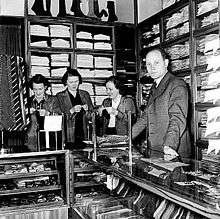Haberdasher
 Paavo Nurmi, in 1939, at his Helsinki haberdashery | |
| Occupation | |
|---|---|
Occupation type | Clothing |
Activity sectors | Retail |
| Description | |
| Competencies | Sewing, tailoring |
Related jobs | Tailor |
A haberdasher is a person who sells small articles for sewing, such as buttons, ribbons and zippers (in the United Kingdom[1]), or a men's outfitter (American English).[2] The sewing articles are called haberdashery, or "notions" (American English).
Origin and use

The word appears in Chaucer's Canterbury Tales.[3] Haberdashers were initially peddlers, thus sellers of small items such as needles and buttons. The word is not thought to have connection with an Old Norse word akin to the Icelandic hafurtask, which means "peddlers' wares" or the sack in which the peddler carried them.[4] If that had been the case, a haberdasher (in its hypothetical Scandinavian meaning) would be very close to a mercier (French).
Since the word has no recorded use in Scandinavia, it is most likely derived from the Anglo-Norman hapertas, meaning "small ware".[5] A haberdasher would retail small wares, the goods of the peddler, while a mercer would specialize in "linens, silks, fustian, worsted piece-goods and bedding".[6]
Saint Louis IX, King of France 1226–70, is the patron saint of French haberdashers.[7][8] In Belgium and elsewhere in Continental Europe, Saint Nicholas remains their patron saint, while Saint Catherine was adopted by the Worshipful Company of Haberdashers in the City of London.[9]
See also
| Wikimedia Commons has media related to Haberdashers. |
| Look up haberdasher in Wiktionary, the free dictionary. |
References
- ↑ Oxford English Dictionary, 2nd edition, 1989: "A dealer in small articles appertaining to dress, as thread, tape, ribbons, etc.
- ↑ Collins Dictionary of the English Language (1979)
- ↑ "The British Library, The Canterbury Tales, Caxton's first edition". Molcat1.bl.uk. Retrieved 2014-06-12.
- ↑ Oxford English Dictionary, 2nd edition, 1989: haberdash, n. "Connexion with mod.Icel. haprtask 'haversack' is not possible."
- ↑ "Online Etymology Dictionary". Etymonline.com. Retrieved 2014-06-12.
- ↑ Sutton, Anne F. (2005). The Mercery of London: Trade, Goods and People, 1130–1578, p.118. Ashgate Publishing, Ltd. ISBN 0-7546-5331-5
- ↑ "Catholic Culture, St. Louis IX". Catholicculture.org. 2008-08-25. Retrieved 2014-06-12.
- ↑ "Patron Saints Index". 2heartsnetwork.org. 2011-02-16. Archived from the original on 2014-01-13. Retrieved 2014-06-12.
- ↑ "Company HIstory". Haberdashers. Retrieved 2014-06-12.